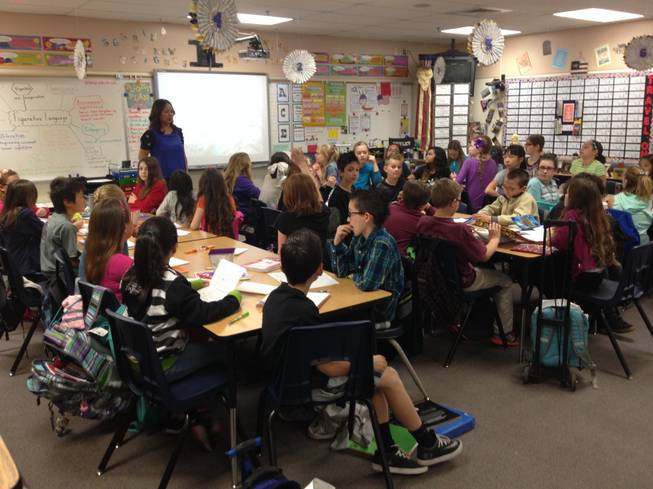
Ian Whitaker / Las Vegas Sun
Students in the packed fifth-grade classroom of teacher Vanessa Whitley on Friday, March 6, 2015, at Twitchell Elementary School.
Monday, Feb. 15, 2016 | 2:01 a.m.
“Nevada: A world within. A state apart.” Our state’s slogan gets it right in many ways. Nevada offers enchanting desert landscapes, pristine lakes and rugged mountains. It also boasts such quirky gems as the Extraterrestrial Highway, the Clown Motel, the Neon Museum and, of course, the famed Las Vegas Strip.
Nevada truly is “a world within” as the slogan suggests, but while its diverse beauty may set the “state apart,” so does its dismal performance in multiple national rankings.
We struggle to educate our children properly. We can’t keep track of our money. We lack doctors. We’re living in underwater homes. We’re prone to deep sadness.
And so time and again, Nevada winds up the loser in national rankings pitting states against one another on any number of measures. We’re a bottom dweller on lists that start with the best and a top feeder on lists you’d want to avoid.
With the majority of Nevada residents living in Southern Nevada, Las Vegas’ influence can’t be denied. Many of the state’s problems are interconnected, rooted in Las Vegas’ rapid growth, transient population and the lingering effects of the recession.
On the bright side, we can go only up from here.
The Sunday examined some of Nevada’s most embarrassing rankings and spoke with experts about how we can overcome the challenges.
••••
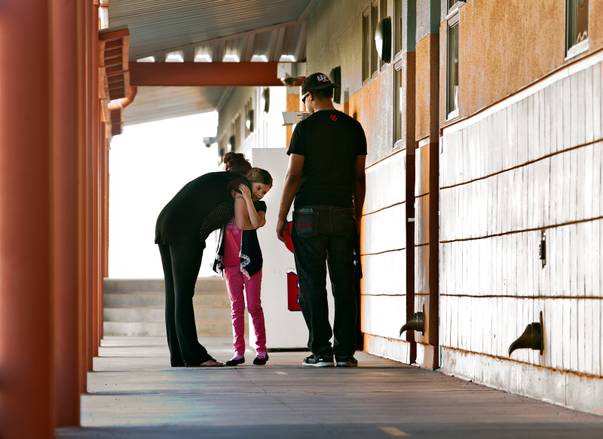
Sandy Valley resident Shana Hairston hugs her daughter goodbye as husband Michael Hairston Jr., stands by on Thursday, Sept. 24, 2015. Parents, teachers and administrators agree the Sandy Valley school is in desperate need of renovation after a flood three years ago damaged classrooms and the portable gym.
EDUCATION
The problem
When it comes to teaching our children, Nevada’s report card is a disaster. For example, the state received a D grade and a No. 51 ranking among all states and the District of Columbia in Education Week’s annual “Quality Counts” report released this year. Education Week is published by Editorial Projects in Education, a nonprofit group that aims to raise understanding of critical issues facing American schools.
The organization evaluated states in three categories: chance for success, which examined the role of education in a person’s life; K-12 achievement, which assessed public school performance and improvement; and school finance, which examined educational spending and funding. Nevada received a D in all three categories.
To anyone familiar with Las Vegas, the ranking shouldn’t be a surprise. The Clark County School District, the fifth-largest in the nation, has long been plagued by problems, including low graduation rates, subpar test scores, crowded classrooms and a severe teacher shortage.
Nevada’s lackluster education system is evident in students’ test scores. The 2015 National Assessment of Educational Progress, a standardized test given to American students, showed:
• Only 29 percent of Nevada fourth-graders were proficient in reading.
• Only 32 percent of Nevada fourth-graders were proficient in math.
• Only 27 percent of Nevada eighth-graders were proficient in reading.
• Only 26 percent of Nevada eighth-graders were proficient in math.
Once again, Nevada students fell near the bottom when ranked against other states and districts.
How we got here
Las Vegas’ rapid growth is at least partly to blame. The Clark County School District couldn’t keep pace hiring teachers and building new schools to accommodate all the children entering the district.
Although the state made a major stride during the 2015 legislative session, when lawmakers voted to increase K-12 funding by more than $400 million, Nevada has chronically underfunded its public education system. CCSD’s supporters say the lackluster funding has made it difficult for CCSD to recruit and retain quality leaders and staff, provide adequate materials and keep up with students’ technological needs.
On top of that, the district has a high percentage of English language learning students who need specialized instruction and tend not to perform as well as their peers who are native speakers.
Solutions
The need for a better education system isn’t lost on state leaders. In fact, it was one of the most important issues during the last legislative session.
Gov. Brian Sandoval last year approved an education-reform package that included money to expand full-day kindergarten to every school in the state and to help English language learners.
Ensuring teacher quality also can improve schools, said Holly Yettick, director of Education Week’s Research Center. That can be done by increasing teachers’ salaries, giving them enough supplies and making sure schools have good administrators and professional development opportunities, she said.
Another important consideration is class size. Large classes burn out teachers, Yettick said. It’s not uncommon for an upper-grade teacher to have 250 students in all of his or her classes combined.
“How are you ever going to grade all those papers?” Yettick asked.
To boost graduation rates, schools need to have more programs for ninth-graders, since studies show that students’ performance and attitude in ninth grade in large part determine whether they will drop out of school later, Yettick said. Developing engaging, creative curricula also can help dropout rates.
Many improvement efforts, however, hinge on students being prepared to learn, which often doesn’t happen if they live in poverty, said Terri Janison, a former Clark County schools trustee and vice president of community development at the United Way.
“As a community, I don’t think we have an organized social services structure to assist families in poverty,” she said.
The Las Vegas community does a great job organizing efforts such as backpack drives filled with school supplies, Janison said, but it needs to go a step further by asking families about their specific needs. If the community can help keep families become more stable, there’s a greater likelihood their children will fare better in school, Janison said.
••••
HEALTH CARE
The problem
Nevada severely lacks physicians of all types, but especially in primary care medicine, general surgery and psychiatry. Residents frequently must navigate long waiting lists to get in the door to see a physician.
Nevada had 197.4 working doctors for every 100,000 people, ranking it 47th in the nation for number of doctors, according to a 2015 report from the Association of American Medical Colleges. Only Wyoming, Idaho and Mississippi fared worse.
How we got here
This isn’t a new problem. Nevada’s ranking has fallen steadily in the doctors study. Nevada ranked 44th in the 2009 report, 45th in 2011 and 46th in 2013.
For primary care physicians, Nevada ranked 48th among states, with only 69.8 primary care physicians per 100,000 residents.
Why? Nevada experienced explosive growth over the past few decades, and even though more physicians moved to practice here, it wasn’t enough to keep pace. Plus, Nevada lacks residency and fellowship programs, meaning newly minted doctors typically receive their postmedical-school training in other states. That’s important, because doctors often end up practicing medicine where they complete their residencies and fellowships.
In addition, recruitment remains a barrier, as many doctors shy away from Las Vegas when they hear negative commentary about its schools and family environment, said Tabor Griswold, health services research analyst for the University of Nevada School of Medicine.
Solutions
Progress already is underway to bring more doctors to Nevada. UNLV and Roseman University of Health Sciences each plan to open a medical school in Southern Nevada. Both hope to start classes in 2017 and aim to foster a sense of community among students to make them want to practice medicine here.
Key, however, will be offering residencies and fellowships here as well. Last year, Gov. Brian Sandoval approved $10 million for the development of graduate medical education programs. In December, the Valley Health System announced it would add eight residency programs at its hospitals. And MountainView Hospital announced accreditation of its new internal medicine residency program.
Griswold said the state needed to offer loan-repayment programs for physicians and craft a better message about the positive aspects of the community.
“We need to show them that we have this great place to have their families,” she said.
Nevada also needs to grow future physicians by providing students solid STEM (science, technology, engineering and math) education, said Keith Clark, outreach director for the state Office of Rural Health. Doing so could be particularly helpful to rural communities because children from them one day may want to practice medicine in their hometown.
••••
MENTAL HEALTH
The problem
Mentally ill patients are flooding Nevada emergency rooms. The state lacks enough mental health providers to meet demand. Jails and prisons essentially have become Nevada’s largest mental health facilities.
Not surprisingly, Mental Health America, an advocacy organization, ranked Nevada 49th among states and the District of Columbia for effectiveness in addressing mental health issues. The state’s low ranking indicates a higher prevalence of mental illness and insufficient access to care. In fact, Nevada ranked 51st for access to care.
How we got here
The situation isn’t new. Nevada’s challenges have received considerable attention over the past few years.
State officials came under fire in 2013 after the Sacramento Bee exposed Nevada’s practice of busing mentally ill patients out of state. The investigation led to a lawsuit against Nevada and Gov. Brian Sandoval, who created a Behavior Health and Wellness Council to address the problems. The council issued 16 recommendations for how to improve Nevada’s mental health services.
Solutions
The Wellness Council suggested that the state add inpatient psychiatric beds in Southern Nevada, boost the state’s mental health workforce, extend the reach of mobile crisis units that serve children, create an information portal for families and enhance peer services. The state already has acted on some of the recommendations and is revamping the children’s mental health system thanks to an $11 million federal grant.
Recruiting more mental health providers — psychiatrists, psychologists, therapists, social workers, etc. — will lead to shorter waiting lists for services. Easing licensing hurdles can encourage professionals to move here. Training mental health providers on substance abuse issue would be wise as the two often go hand in hand.
Beyond that, Nevada would better serve people with mental health problems and their families if it placed a greater emphasis on community programs that use practices founded on scientific research, said Sandra Stamates, president of Nevada’s chapter of the National Alliance of Mental Illness. For instance, the state is piloting an evidence-based program to help people who recently experienced their first episode of psychosis.
••••
PERSONAL FINANCE
The problem
When it comes to taking care of personal finances, Nevadans are a mess.
The state has the seventh-highest bankruptcy rate in the nation. If they lost their income, more than half of residents wouldn’t have enough savings to live at the poverty level for three months. Sixty percent of Nevadans have subprime credit, meaning they don’t qualify for loans at typical rates and must rely on high-interest financing such as loans from payday lenders.
For these reasons and more, Nevada was ranked 48th among states for personal finance in 2016, according to the nonprofit Corporation for Enterprise Development. The state ranked No. 48 in 2015, No. 50 in 2014 and No. 51 in 2013.
How we got here
Las Vegas’ transient population has contributed to residents’ financial woes, said Michele Johnson, president and CEO of the Financial Guidance Center, a nonprofit agency that provides financial counseling and education. People move to Las Vegas without proper financial cushions, so when they encounter such setbacks as increased insurance or childcare costs, or they can’t find a decent-paying job, they have nothing to fall back on.
In addition, many residents are reliant on tips, which can be difficult to manage effectively, Johnson said. And like everywhere, parents pass bad financial habits to their children.
The result: a compounding community problem.
“We don’t talk about it nearly as much as we should,” Johnson said. “People don’t generally volunteer to learn how to handle their money. They think they do just fine.”
Solutions
By law, Nevada high school graduates must have received financial literacy instruction. Nevada Revised Statutes lay out a roadmap for what must be covered, such as managing finances, developing savings plans and understanding credit cards, credit scores and investing, but “it’s rather vague, and it’s unfunded,” Johnson said. Plus, Nevada’s high dropout rate means some students don’t receive the instruction. The state should require financial literacy education for students of all ages, starting when they enter school, Johnson said.
Nevada corporations can help by offering financial literacy courses to employees.
“Stress and financial problems cause marital problems that cause problems at work,” Johnson said. “One problem begets another.”
Individuals need to step up as well and take charge of their personal finances by taking courses offered at banks or the Financial Guidance Center, learning how to budget and not being afraid to ask for help.
“It’s a matter of making it a goal that you as a family, couple or individual are going to become financially capable,” Johnson said.
••••
UNDERWATER MORTGAGES
The problem
Las Vegas has the largest share of underwater homeowners of any large metropolitan area in the United States, according to Zillow.
During the third quarter of 2015, 22 percent of Las Vegas homeowners were underwater, meaning they owed more on their mortgage than their home was worth. Another 19 percent effectively were underwater because they had less than 20 percent equity in their home and wouldn’t be able to afford selling it and buying another.
How we got here
A good number of Las Vegas homes — 44 percent — were built after 2000. Home prices were skyrocketing, rising more than 125 percent between January 2000 and the pre-recession peak in May 2006, said Svenja Guvell, Zillow’s chief economist. People were buying homes they barely could afford, often with loans that required little downpayment.When the economy collapsed, so did Las Vegas’ real estate market. Housing prices fell drastically, with valley homes losing almost 63 percent of their value from 2006 to 2012. At the same time, people lost their jobs, and unemployment spiked.
Solutions
If underwater homeowners want to move, their options are limited: pay off their outstanding mortgage balance, negotiate a short sale with their lender, wait for the home’s value to appreciate or stop paying and fall into foreclosure. All likely take a healthy dose of patience.
“Time is going to heal most of these wounds,” Guvell said.
The number of underwater homeowners in Las Vegas should continue to decrease, but it might take another eight years to undo the damage done by the recession, Guvell said.
In the meantime, homeowners shouldn’t give up on their underwater homes, even if they feel discouraged. Neglecting to do home repairs and maintenance hurts the resale value of the home and others around it.
Residents also can ask their bank or an advocacy organization, such as the Financial Guidance Center, about federal programs intended to help struggling underwater homeowners.
••••
SUICIDE
The problem
Nevada has one of the highest suicide rates in the nation. A total of 573 residents killed themselves in 2014.
At 20.2 suicides per 100,000 people, Nevada tied Colorado for the fifth-highest suicide rate in the nation, trailing only Montana, Alaska, New Mexico and Wyoming, according to the American Association of Suicidology.
The high ranking isn’t an anomaly. Nevada held the No. 1 spot in the 1990s, then fluctuated among the top five over the next decade, said Richard Egan, of the state Office of Suicide Prevention. In 2013, Nevada ranked sixth nationally for suicide.
More people die by suicide in Nevada than are killed in motor-vehicle crashes or homicides, sometimes combined. And state figures do not include tourists who kill themselves while visiting Nevada.
How we got here
A Robert Wood Johnson Foundation study theorized that Western states have higher suicide rates because of residential instability. Transient populations lead to fewer social ties and a weakened emphasis on marriage and religion.
Add in the loss of a job, home or loved one, mental health issues or drug use, and people may “feel like they’re in a dark cave and no one can help them,” Egan said.
Solutions
Most people who kill themselves exhibit warning signs. That’s why raising awareness about those warning signs, which include talking about wanting to die, sleeping too little, researching ways to kill oneself or expressing a sense of hopelessness, is crucial.
The Nevada Office of Suicide Prevention organizes training sessions to teach people about suicide risk and warning signs. Courses are open to all residents, organizations and companies, and can be scheduled by calling 702-486-8225.
Egan also urged Nevada and the nation to funnel more money into suicide prevention efforts.
“Look how much effort and funding we put toward other avenues,” he said. “It’s time to put more effort to help those individuals (struggling with suicidal thoughts).”
Egan also suggested the state begin instituting “social and emotional learning” in elementary schools to teach children coping skills.
••••
UNEMPLOYMENT
The problem
Las Vegas remains at the bottom of the heap when it comes to employment, according to the U.S. Bureau of Labor Statistics.
Las Vegas’ unemployment rate was 6.3 percent in November (the most recent data available), worst among U.S. metropolitan areas with more than 1 million residents.
The valley still is dealing with the “hangover from the recession,” said Robert Lang, executive director of Brookings Mountain West at UNLV.
How we got here
“Construction was just too large of a share of (gross domestic product) for the region,” Lang said. “It wasn’t sustainable.”
In 2007, construction jobs accounted for 12 percent of the region’s economy; now they make up 6 percent.
Nevada has made a “pretty good recovery,” Lang said, but it hasn’t been able to keep up with states that suffered less during the recession.
On the upside, sectors such as health services and information technology are growing locally, Lang said.
Solutions
Efforts to diversify the state economy, including within tourism, remain key to continued recovery.
“The thing we do best, remember, is tourism,” Lang said. “But you need to diversify your core while investing in it.”
Because today’s tourists don’t gamble as much as previous generations, it’s important to look for other moneymakers. Strip operators did that by expanding into the dayclub sector to lure young people to fork over money for cabanas and bottle service.
The next big opportunity: events on or near the Strip. T-Mobile Arena is scheduled to open in April, but the region could benefit from a stadium as well, Lang said.
Diversification opportunities exist beyond the Strip as well. In December, the Nevada Legislature approved tax breaks and incentives to bring electric-car startup Faraday Future to the 18,000-acre Apex Industrial Park in North Las Vegas.
If that area is built out fully, a quarter of the region’s GDP could come from Apex, pumping billions into the economy, Lang said.
Developers and regional leaders also need to emphasize to companies interested in relocating here the benefits of McCarran International Airport — its convenience, its connectivity to the Strip and its large volume of daily flights.
“That airport is the greatest gift the city has,” Lang said.
••••
DOMESTIC VIOLENCE
The problem
Every few weeks in Nevada, women are fatally shot, stabbed or beaten by their boyfriends or husbands. It’s so rampant that, almost every year, Nevada nears the top of the Violence Policy Center’s ranking of states with the highest rates of women killed by men.
Nevada has been among the 10 worst states for 17 of the past 18 years, including seven years in the No. 1 spot. In 2015, Nevada ranked fifth worst, with 1.95 women killed per 100,000.
How we got here
What’s driving men to hurt and kill women here? Experts say a number of triggers contribute to the problem, including financial stressors, alcohol and drug use, a lack of extended family nearby to serve as victims’ safety nets and the vast desert landscape, where abusers sometimes abandon victims.
On top of that, resources to help victims escape abusers are limited. For example, Metro Police disbanded its domestic violence unit in July as part of a department reorganization. Many detectives who specialized in domestic abuse cases became generalists that investigate all types of crime. The change angered detectives in the department and left some community organizations uneasy.
* Both men and women, regardless of sexual orientation, can be victims or abusers.
Solutions
The Nevada Network Against Domestic Violence suggests state officials focus on these fixes to curb domestic violence:
• Increase funding for domestic violence-related programs and social services that provide a safety net for victims.
• Hold abusers more accountable in the criminal justice system. “Often times, charges may be pleaded down,” which lets abusers off the hook, said Lisa Lynn Chapman, the network’s communications coordinator.
• Bolster the effectiveness of protection orders by requiring suspects to relinquish firearms.
• Start universal background checks for anyone who wants to buy a gun.
“We do have a very strong group of people in this state who believe this is a big issue,” Chapman said. “I do believe (improvement) is possible.”
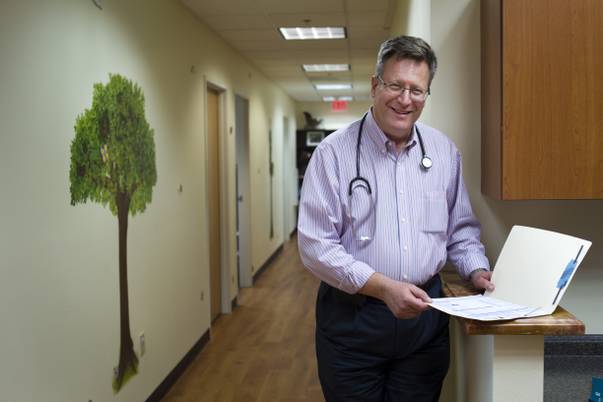
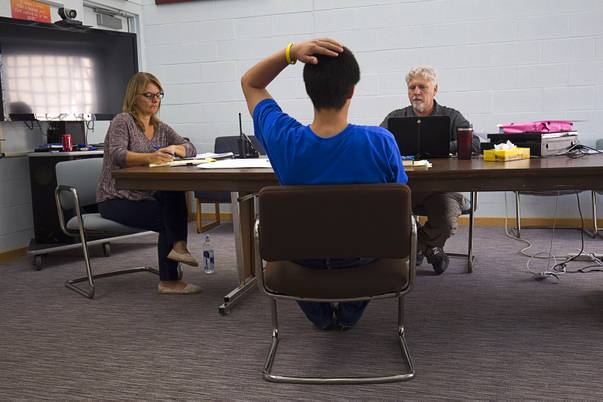

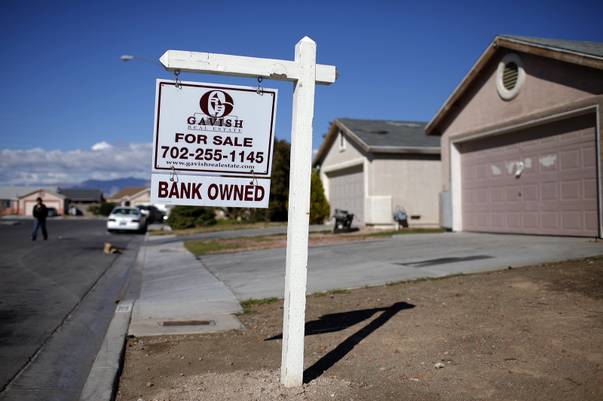
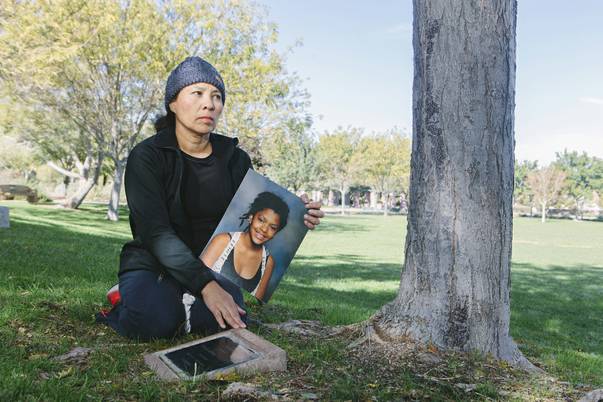
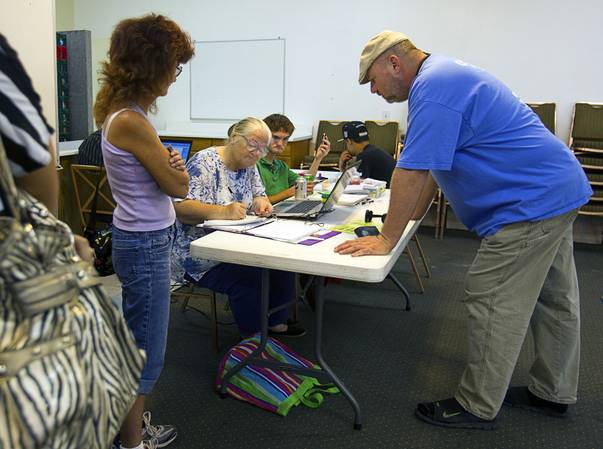
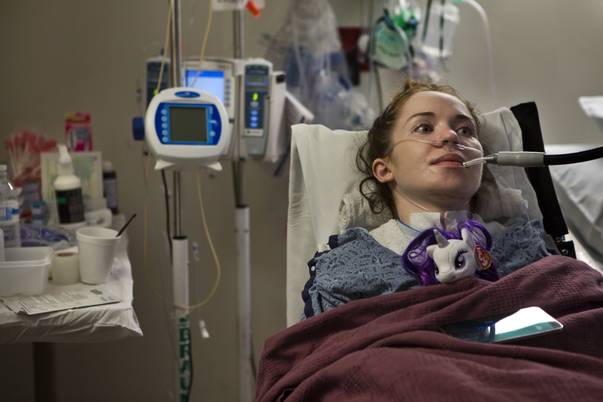

Join the Discussion:
Check this out for a full explanation of our conversion to the LiveFyre commenting system and instructions on how to sign up for an account.
Full comments policy